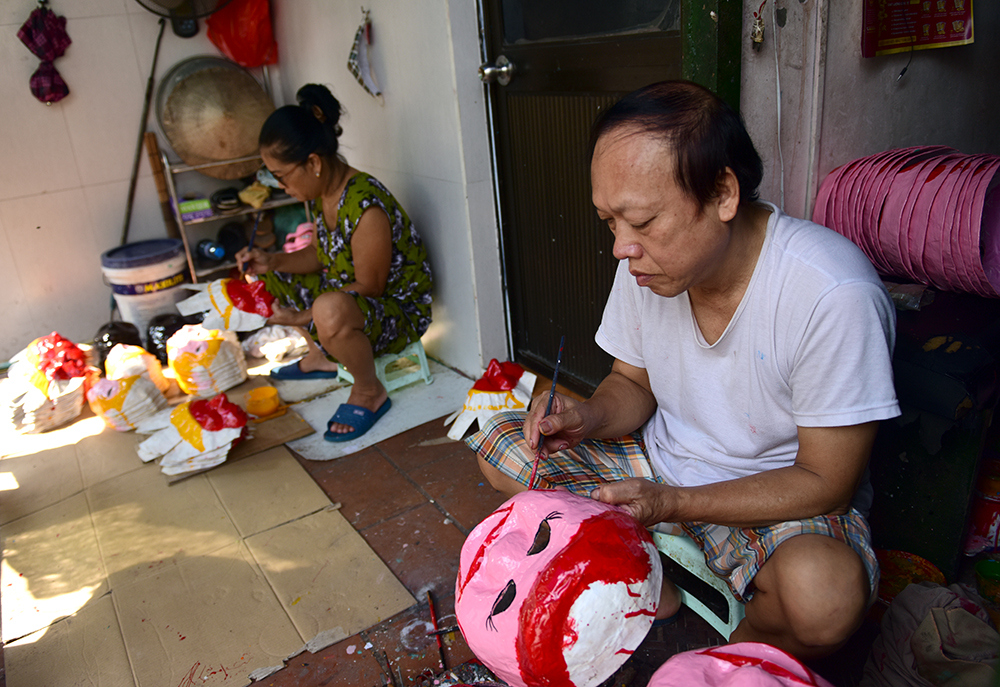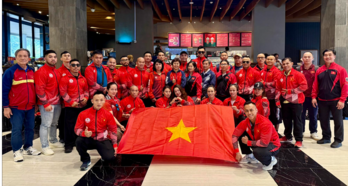Mid-Autumn Smile
The moment when the wind begans to change, and the moon is getting full, is when many people remember the days of their childhood enjoying dragon and lion dances, lantern parades and parties.

Students making traditional Mid-Autumn Festival lanterns
Mid-Autumn Festival is a happy day. But several years ago, the mid-autumn season brought sadness to artisans in the craft village where they make traditional toys, as modern imported toys were sold everywhere. However, in recent years, it seems that the Mid-Autumn Festival has found its origin.
Sad time
.jpg)
Each Mid-Autumn season, Nguyen Thi Tuyen, an artisan in Hau Ai Village, Van Canh Commune, Hoai Duc District, in Hanoi, who is also called Tuyen "paper doctor" because she silently makes the star-shaped lanterns, paper doctor (Vietnamese folk toy) to provide for schools, museums and cultural centres.
The family of Nguyen Thi Tuyen, at Hau Ai village, Van Canh commune, Hoai Duc district, Hanoi, has had many generations who have made traditional the Mid-Autumn toys. In the past, many Hau Ai villagers made Mid-Autumn toys, especially the star-shaped lanterns. At the end of summer, farmers gathered to collect bamboo and other kinds of paper. From the age of seven years old, she knew how to make the lights. Gradually, she learnt all the skills and has followed the trade until now. However, as modern toys with all their brilliant colors have become readily available, the people of Hai Ai hamlet have lost their place in the world. Nguyen Thi Tuyen still makes folk toys. For her, it is a responsibility to preserve the culture of the family, as well as an remaining an example to teach children.
Tuyen has a career spanning nearly 45 years, meanwhile Nguyen Van Hoa and Dang Huong Lan who are one of the last artisan families to keep the "secrets" of making traditional paper masks, in Hang Than Street, Hanoi, have half a century of experience in this profession. Artisan Hoa shared that the masks are not only a toy, but also have profound implications. In the past, the most common masks were the Earth God masks and the rabbit masks. The iconography of the Earth God masks originated from the thinking of agricultural residents, highlighting the role of the land. Meanwhile, the rabbit symbolises the moon, in the eighth month of lunar calendar, when it is the time of the full moon of the year. However, over time, these traditional paper masks have gradually fallen into oblivion and only a few artisans remain attached to this profession.
The colours of the traditional Mid-Autumn festival are fading causing sadness to artisans who make traditional toys.
Keeping “fire” alight for Mid-Autumn parties
In recent years, artisan Nguyen Thi Tuyen has been invited by the Vietnam Museum of Ethnology to demonstrate how to make the Mid-Autumn toys. Initially, she did not expect much, besides being able to sell more toys.
But there are more units that have invited her to introduce how to make Mid-Autumn toys. From Hau Ai village, she arrived to Kim Ngan communal house in Hanoi's Old Quarter. Her traditional toys, such as “paper professor” or the star-shaped lanterns, attracted the attention of the children. The children ask her for instructions on how to make the lights. They are happy to make a lamp.
Each Mid-Autumn season, Tuyen has to "schedule" the demonstrations on how to make the Mid-Autumn toys, as more and more units organise the Mid-Autumn Festival with traditional charm.

With nearly 40 years of experience in this profession, the couple of Nguyen Van Hoa and Dang Huong Lan are one of the last artisan families to stick to and keep the "secrets" of making traditional paper masks
Recently, the book street management board also organised an exchange programme "Behind the mask is a cultural story" with artisan Nguyen Van Hoa, in Hanoi Book Street space, December 19 Street, Hoan Kiem district, Hanoi. The event attracted hundreds of children. The exchange programme was more exciting when artisan Nguyen Van Hoa brought his gear to the stage, making paper masks and teaching the children how to make them at home. The children were delighted with the demonstration and the programme only ended when the children had made their own masks.
Preserving traditional Mid-Autumn features
Nearly ten years ago, perhaps no one knew that the Mid-Autumn Festival programme in the Vietnam Museum of Ethnology would contribute to bringing traditional toys and folk games back to modern life. It is not only organisations but also individuals that contribute to the return of traditional toys.
In 2014, artist Trang Thanh Hien together with young people organised the programme "Together with children create paper mask" in the Museum of Fine Arts. She did not think that many parents would bring their children to the programme. As a painter and a researcher, she felt sorry that the traditional paper marks had gradually fallen into oblivion.
As a result, for several years, on the occasion of the Mid-Aumtum festival, painter Trang Thanh Hien and his colleagues organised programmes to promote the paper masks.
Also participating in the exchange programme "Behind the mask is a cultural story" with artisan Nguyen Van Hoa, painter Trang Thanh Hien, and artisan Nguyen Van Hoa, there is Ngo Quy Duc, who is head of Hanoi Classy club. Ngo Quy Duc is very enthusiastic about restoring folk toys and folk games. He visited artist Nguyen Van Hoa’s house for the first time ten years ago. First he purchased masks and then invited artist Nguyen Van Hoa to participate in his programme on traditional toys. Through his programme, he helped the children "upstream" to find folk paper masks.
It is necessary to have “bridge” such as painter Trang Thanh Hien, or Ngo Quy Duc, to connect the artisans and the community.
Original Vietnamese Mid-Autumn Festival
There are many different sources on the origin of the Mid-Autumn Festival. According to the VNA, based on the epitaph in Doi Pagoda (1121), the Mid-Autumn Festival was officially held at the Thang Long Ancient Capital by the Ly Dynasty, with many interesting activities such as boat racing, water puppetry performances and lantern parades. During the Le – Trịnh period, the Mid – Autumn Festival was an extremely luxurious event held by the Lord.
.jpg)
According to Vietnamese customs, on the occasion of Mid-Autumn Festival, the family gathers together and has dinner. They watch the moon and wish for a good harvest. The traditional cake is a moon cake made with many fruits. They also have fruit jams dyed in various colours, green, red, white or yellow. Children spend time on the street playing, singing and talking happily.
During this holiday, children make masks and toys such as elephants, horses, unicorns, lions, dragons, deer, fish, butterflies, mantis, and flower branches. In the past few years, there have also been many plastic toys and modern cartoon characters. The Mid-Autumn Festival is the time for children to enjoy their childhood.
Children go from house to house singing and playing with their toys. The sound of loud drum beats, of laughing and of people talking makes the day become memorable.
Olympic folk games of Vietnam
To mark the occasion, the Hanoi Book Street Management Board held the programme "Full Moon Book Fair", and it seems that the Trinh Cong Son walking street area in Tay Ho district exploded with the Olympic folk games of Vietnam. This is the first time that folk games were held on a large scale for young people, organised by the UNESCO Center for International Cultural Exchange and Preservation (ICEP – Hanoi Classy) and San Dinh Group. Within the framework of the event, the organising panel kicked off the qualifying rounds of the Olympic Folk Games with four traditional games, namely bag jumping, Mandarin Square Capturing, walking on stilts and pitching pennies.
According to a representative of San Dinh Group, Nguyen Thi Thuy Van, many of the folk games help children move, practice ingenuity and develop intellectually. "Our biggest wish is to help young people understand more about folk games helping the folk games come back to life," Van added. A total of 14 folk games were introduced by the San Dinh group. Not only enjoyed by children, many young people and adults also had the opportunity to return to their childhoods through playing folk games. The activity was expected to contribute to spreading the unique cultural values of Vietnamese folk games, engaging communities and different family generations, as well as developing life skills for younger generations.
The recent Mid-Autumn season, is returning to origin. The toys of the Mid-Autumn Festival have found a smile and harmony in the child's laugh.
In the memory of each person always exists a Mid-Autumn Festival from their childhood, and everyone wants their children to experience the beautiful Mid-Autumn Festival. And as such, the traditional way of receiving the Autumn Festival is continued from generation to generation./.
NDO
| Share |
-
 Vietnam wins triple runner-up titles at world bodybuilding championships
Vietnam wins triple runner-up titles at world bodybuilding championships
- Da Nang remains Vietnam’s fastest 5G city
- Vietnam to host Asian Esports Championships for the first time
- Vinh Long celebrates Ok Om Bok Festival
- Mekong Delta cuisine delights visitors at Autumn Fair 2025
- Vietnamese athletes undergo training in France to prepare for Olympics


